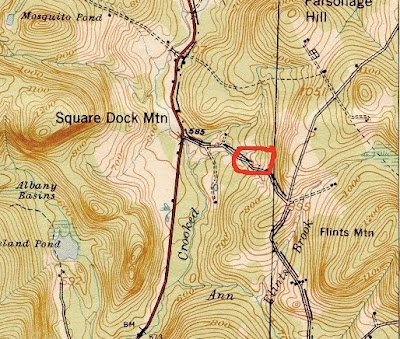 I. Saunders cellar hole
I. Saunders cellar holeSoft, white-and-yellow flowers poked up through last fall’s leaves and contrasted with hard, gray granite. Whoever lived there had been very good with stone, and with flowers. The people who positioned each were long dead. Their house had fallen in and rotted away, but I knew I would have liked them if only for where and how they chose to live. The cellar hole still perched beside the steep dirt road. Holes don’t usually perch but this one did.
 Through deep woods, I pulled my ATV into what would have been their dooryard on the uphill side. From there, I could oversee what would have been the view from the house when it stood. Hardwoods across the road were bare of leaves and a mountainous horizon was visible to the west. The view would have been unobstructed when the farm operated back in the nineteenth century and sunsets must have been stunning. That was my second indication of how much intelligence and planning went into laying out that farmstead. Getting off my machine, I was careful not to step on more beds of flowers the like of which I’d never seen before.
Through deep woods, I pulled my ATV into what would have been their dooryard on the uphill side. From there, I could oversee what would have been the view from the house when it stood. Hardwoods across the road were bare of leaves and a mountainous horizon was visible to the west. The view would have been unobstructed when the farm operated back in the nineteenth century and sunsets must have been stunning. That was my second indication of how much intelligence and planning went into laying out that farmstead. Getting off my machine, I was careful not to step on more beds of flowers the like of which I’d never seen before. Next, I noticed a dug well covered with an old piece of galvanized steel roofing. Then I walked down to the cellar hole for a closer look. It was impressive. Massive chimney bases told me the house had probably been a cape with large fireplaces on the gable ends. From one uphill corner a galvanized, steel pipe stuck out - a gravity feed from the uphill well still trickled after all these years.
Next, I noticed a dug well covered with an old piece of galvanized steel roofing. Then I walked down to the cellar hole for a closer look. It was impressive. Massive chimney bases told me the house had probably been a cape with large fireplaces on the gable ends. From one uphill corner a galvanized, steel pipe stuck out - a gravity feed from the uphill well still trickled after all these years.When I got home I pulled out my maps. One old Oxford County map told me that someone named “I. Saunders” lived there in 1858. Another showed him still there in 1880.
It was spring vacation and I’d finally found time to renew one of my favorite pastimes - exploring abandoned neighborhoods. I had focused on Albany Township, Maine. It’s not a municipality anymore, but it was once. Judging from the 1858 map, it had almost as many people as Lovell did, but seems to have lost many more in the post-Civil War outmigration to the west - so many that it ceased being a town and gave over control to the State of Maine. I’d looked it over from my pickup truck over the past ten years when I felt like driving around on Friday-night dates with my wife, and noticed some building going on. Some of the old neighborhoods are being repopulated. I saw homes going up next to or behind two-hundred-year-old cellar holes. People today obviously agree with 19th century pioneers about the best places to site a house.
 1858 Map
1858 MapNobody built near the Saunders cellar hole though - too steep for them I’d guess. There are ledges on the hillside above and it looks like Mr. I. Saunders pulled some large flat stone down for his house foundation. He used two massive 5X5-foot slabs to form one corner and a few others to form parts of the cellar walls. Don’t know exactly how long they’ve been in place, but they haven’t moved after at least a century-and-a-half of freezing and thawing. As I said, he was good with stone. He might have been assisted by relatives as the 1858 map shows other Saunders farmsteads above and below his. Brothers perhaps? The Saunders farm above had disappeared on the 1880 map. Did that brother seek his fortune in America’s west as so many others from western Maine did?
 1880 Map
1880 MapLooking at a 1915 USGS map to be found online on a University of New Hampshire web site, I could see there was still a house there where I. Saunders had built it and quite a few acres were still clear on both sides of the steep dirt road.
 1915 USGS map
1915 USGS mapOn the 1943 map, some of the land was still clear but the house was gone. The 1963 map shows the forest having overtaken everything.
 1941 USGS map
1941 USGS mapAs of last week, a few trees left from his apple orchard stood here and there between stone walls, and those delicate, white-and-yellow flowers were still blooming.



















